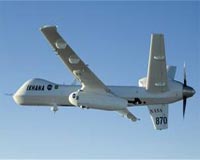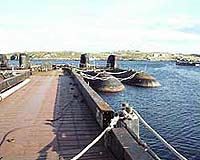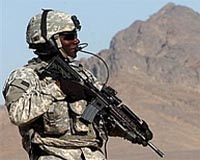
Russian Arms in Latin America
U.S. Secretary of State Condoleezza Rice raised the issue of large-scale Russian weapons exports to Venezuela during her recent visit to Moscow. But the Kremlin says arms deals with Caracas are in keeping with international agreements.
More and more Russian weaponry goes to Latin AmericaRussia has bolstered its position in Latin America's arms market in recent years. State-controlled arms exporter Rosobornoexport, which accounts for 85 percent of Russia's weapons sales, says Latin America is its third largest market. And company officials say they are working to expand their business in Latin America.
According to the U.S. Congressional Research Service, between 1998 and 2001, Russia supplied $300 million worth of arms to the region. Between 2002 and 2005, that amount doubled. Last year, Russian arms transfers to Venezuela alone topped $3 billion dollars. Russia's other arms clients in the region include Mexico, Brazil, Colombia, Chile, Argentina, Ecuador and Uruguay.
The Washington-based Council on Hemispheric Affairs says Moscow's military sales to Venezuela include air-defense systems and fighter aircraft, along with a joint-venture weapons factory to produce up to 50-thousand rifles a year.
The Council's director, Larry Birns, says Russia's emergence as a major arms supplier to the region coincides with efforts by some Latin American countries to modernize their arsenals.
Venezuela bought Sukhoi SU-30MK fighters to replace aging F16s"In the aftermath of the military regimes in Latin America, the military needs of these countries suffered periods of plummeting budgets and marginal status within society. Now the time has come in a number of Latin American countries to renew their military arsenals. And here is Russia with top-of-the-line military equipment, which is much cheaper than [arms] available from the United States or other international arms suppliers," says Birns.
Birns says increased arms exports will likely provide Moscow with greater influence over a number of militaries in the region. At the same time, he says, the United States is being pushed out of an arms market it once dominated.
"What we are seeing here is an unprecedented and unanticipated undermining of the privileged status that the United States traditionally has occupied in Latin America. The United States has been distracted from Latin America by Iraq. This distraction [has] allowed Latin American countries to diversify their relationships in terms of their trade and political associations," says Birns and argues this shift will likely last for years.
But Riordan Roett, Director of Western Hemisphere Studies at The Johns Hopkins University in Washington, points out that 80 percent of Russia's recent arms sales have been to Venezuela. He says Venezuela's President, Hugo Chavez, is trying to boost his standing at home and abroad.
Venezuela bought Russian transport helicopters Mi-26, here seen lifting a U.S. Chinook in Afghanistan"Chavez sees a build up of arms as a way of consolidating his position within Venezuela because he is able to win favor with the armed forces, which were divided at the beginning of his term of office, which appears less so at the present time. Second, [this is intended] to intimidate or impress his neighbors [so] that Chavez and Venezuela will be the dominant sub-regional power. And third, what it actually does is reach out and establish ties with important countries like Russia," says Roett.
The Russia-Venezuela arms trade has generated criticism from the United States. Late last year, the Bush administration lodged a formal complaint with Russia for agreeing to provide Venezuela more than 100-thousand Kalashnikov rifles that U.S. officials say could be used to aid guerillas such as the Revolutionary Armed Forces of Colombia or the National Liberation Army -- the United States calls terrorists.
Mark Bromley with the Stockholm International Peace Research Institute says U.S. Secretary of State Condoleezza Rice pursued these concerns during her recent talks in Moscow with Russia's defense and foreign ministers.
"The U.S. argument is [that] this is completely disproportionate to Venezuelan military needs. And there is a strong likelihood that the weapons being imported or the weapons they're replacing will either deliberately or through omission cross the border and fall in the hands of, for instance, guerillas in Colombia," says Bromley. "The second set of concerns, which the U.S. has raised, has been about the hardware sales, particularly the SU-30 fighter aircraft. This is a much more advanced system than Venezuela needs and will destabilize the military balance in the Andean region."
Most experts agree that Russia's arms trade policy in Latin America is not ideologically driven. On the contrary, it is merely business, says political scientist Riordan Roett.
"I don't think Russians have any particular foreign policy interest in the Western Hemisphere. I think Russia and China are both moving very carefully in the Western Hemisphere precisely so as to not further complicate the bilateral relationship with Washington," says Roett.
Arms transfer specialist Mark Bromley says, "If you look at the relationship Russia has with Venezuela, it is built on natural resources and arms sales. There is not much of an ideological affinity."
Venezuelan president Hugo Chavez before the United Nations General Assembly, in September 2006"I think [Russian leader Vladimir] Putin doesn't really support Chavez when he goes off on these anti-U.S. tirades. There is no shared agenda between Putin and Chavez. Chavez wants to get away from the United States. Russia, unlike any other country in the world, has the technology and is not under the influence of the United States and is willing to sell to Venezuela," says Bromley.
Some analysts say Venezuela's growing military ambitions could drive more U.S. arms sales to the region. And Bromley warns of a possible regional arms race. "A number of countries in South America fund their military acquisitions from the sales of raw materials and, with the price of those commodities on the rise, those countries have a lot more to spend on purchasing military equipment. You put those two things together - - willing suppliers and ample funds - - you could get into a situation where more advanced technologies are being imported into South America than is necessarily in the best interest of countries there," says Bromley.
Despite the risk of an arms race, Bromley says relations among Latin American states are stable. These ties, he adds, have been reinforced by bilateral agreements between countries, including Venezuela, to exchange information about their arms acquisitions.










































